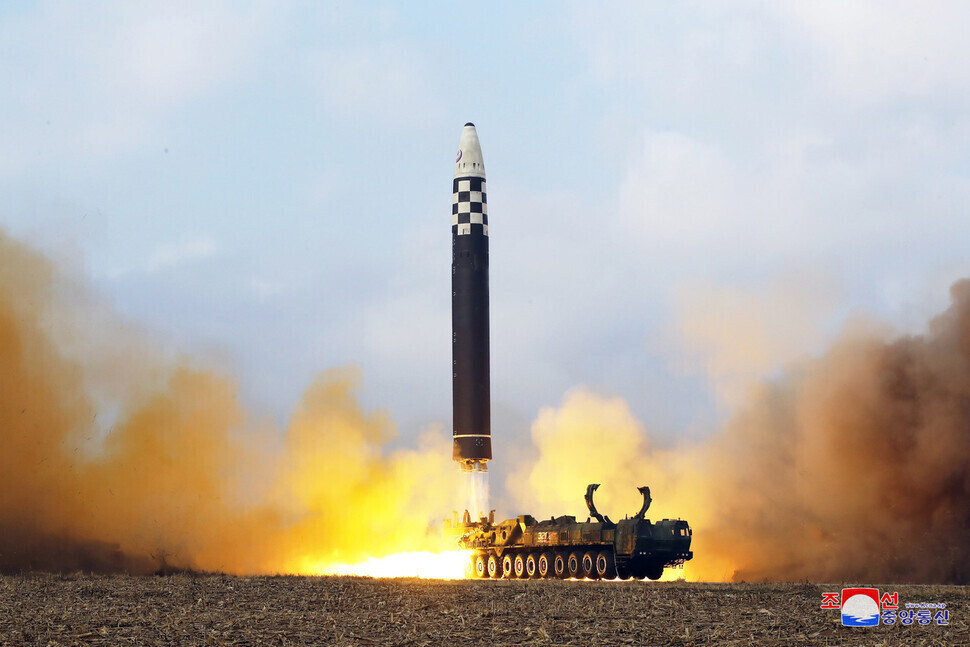hankyoreh
Links to other country sites 다른 나라 사이트 링크
Signs point to solid-fuel ICBM launch by N. Korea, posing test for South’s 3-axis defense

North Korea fired what appears to have been a solid-fuel intercontinental ballistic missile (ICBM) on Thursday, marking the first time the country has ever tested a solid-fueled ballistic missile. Solid-fueled missiles do not require refueling and can be launched instantaneously.
South Korea’s Joint Chiefs of Staff announced that the military had detected a ballistic missile fired into the East Sea from near Pyongyang at 7:23 am on Thursday, saying that the missile “was fired at a high angle from its capital area and fell into the East Sea after a 1,000-kilometer flight.”
The missile’s peak altitude was reportedly lower than 3,000 kilometers. Military officials estimated that the missile’s range would have been around 5,000 kilometers if it had been launched at the normal angle, but after further analysis, they left open the possibility that it could have been an intercontinental ballistic missile. The US has characterized it as an ICBM.
Military officials said this could be a demonstration of a new weapon system by North Korea.
“We believe that North Korea launched a ballistic missile of the intermediate-range missile class or higher of a new system,” a Joint Chiefs official said. “We judge it to be one of the several weapons systems unveiled at the military parade.” North Korea unveiled a new solid-fuel ICBM and other weapons at a military parade in February.
The Joint Chiefs also suggest that it could be an “early-stage test for a satellite launch.” North Korea has said it hopes to complete preparations for its first military reconnaissance satellite by this month.
Notably, South Korea’s military analyzed that the missile may have used solid fuel. Unlike liquid fuel, which takes a substantial amount of time to inject into a missile, solid fuel can be loaded onto a missile like a battery, allowing for rapid launch.
The Yoon Suk-yeol administration in the South has a three-axis system to counter North Korea’s nuclear and missile programs, including the “kill chain” preemptive strike platform, the Korean Air and Missile Defense (KAMD) system, and the Korean Massive Punishment and Retaliation (KMPR) system, but a solid-fueled missile would be difficult to detect and respond to. Solid-fueled missiles also have a faster rate of ascent than liquid-fueled missiles.
“It is possible that North Korea is trying to show off its nuclear capabilities ahead of the Day of the Sun,” referring to Kim Il-sung’s birthday on April 15, “to strengthen internal cohesion, and to show off its reaction to the expanding deterrence of South Korea and the US,” stated the Joint Chiefs. North Korea has not responded to regular calls through the inter-Korean joint liaison office and military communication lines for either coast since April 7.
The presidential office held a standing committee meeting of the National Security Council on the same day, where they “strongly condemned” the launch of the ballistic missile by North Korea and “decided to further strengthen intelligence sharing between South Korea, the US, and Japan based on the normalization of the General Security of Military Information Agreement.”
By Shin Hyeong-cheol, staff reporter; Kwon Hyuk-chul, staff reporter; Bae Ji-hyun, staff reporter
Please direct questions or comments to [english@hani.co.kr]

Editorial・opinion
![[Column] Welcome to the president’s pity party [Column] Welcome to the president’s pity party](https://flexible.img.hani.co.kr/flexible/normal/500/300/imgdb/original/2024/0515/3917157400447943.jpg) [Column] Welcome to the president’s pity party
[Column] Welcome to the president’s pity party![[Editorial] Korea must respond firmly to Japan’s attempt to usurp Line [Editorial] Korea must respond firmly to Japan’s attempt to usurp Line](https://flexible.img.hani.co.kr/flexible/normal/500/300/imgdb/original/2024/0514/2317156736305813.jpg) [Editorial] Korea must respond firmly to Japan’s attempt to usurp Line
[Editorial] Korea must respond firmly to Japan’s attempt to usurp Line- [Editorial] Transfers of prosecutors investigating Korea’s first lady send chilling message
- [Column] Will Seoul’s ties with Moscow really recover on their own?
- [Column] Samsung’s ‘lost decade’ and Lee Jae-yong’s mismatched chopsticks
- [Correspondent’s column] The real reason the US is worried about Chinese ‘overcapacity’
- [Editorial] Yoon’s gesture at communication only highlights his reluctance to change
- [Editorial] Perilous stakes of Trump’s rhetoric around US troop pullout from Korea
- [Guest essay] Preventing Korean Peninsula from becoming front line of new cold war
- [Column] The state is back — but is it in business?
Most viewed articles
- 1[Editorial] Korea must respond firmly to Japan’s attempt to usurp Line
- 2[Editorial] Transfers of prosecutors investigating Korea’s first lady send chilling message
- 3[Column] Welcome to the president’s pity party
- 4Second suspect nabbed for gruesome murder of Korean in Thailand, 1 remains at large
- 5Could Korea’s Naver lose control of Line to Japan?
- 6Major personnel shuffle reassigns prosecutors leading investigations into Korea’s first lady
- 7Naver’s union calls for action from government over possible Japanese buyout of Line
- 8Unexpected rate of AI development requires timely discussion of side effects
- 9US has always pulled troops from Korea unilaterally — is Yoon prepared for it to happen again?
- 10China gains 2 new ambassadors to Korea in form of newborn panda cubs